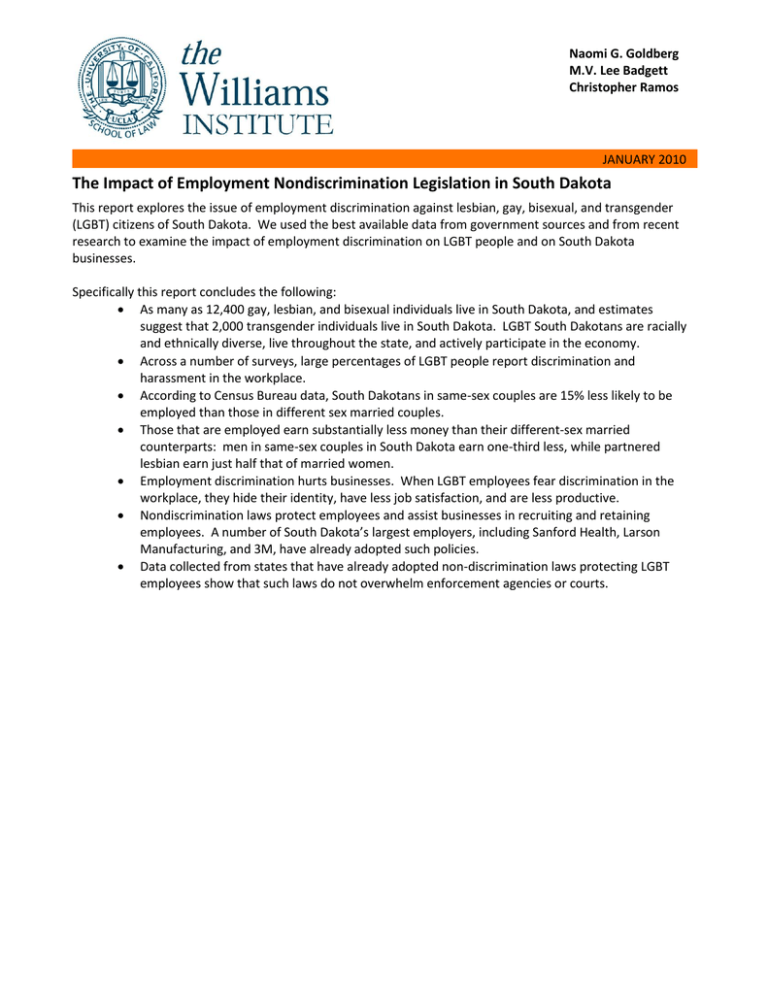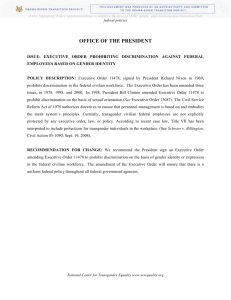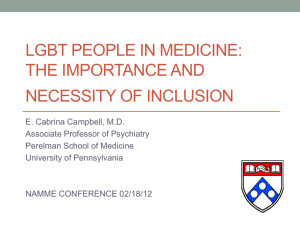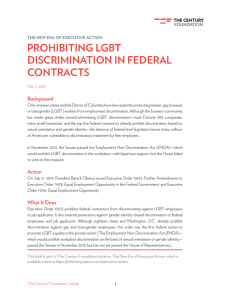
Naomi G. Goldberg
M.V. Lee Badgett
Christopher Ramos
JANUARY 2010
The Impact of Employment Nondiscrimination Legislation in South Dakota
This report explores the issue of employment discrimination against lesbian, gay, bisexual, and transgender
(LGBT) citizens of South Dakota. We used the best available data from government sources and from recent
research to examine the impact of employment discrimination on LGBT people and on South Dakota
businesses.
Specifically this report concludes the following:
As many as 12,400 gay, lesbian, and bisexual individuals live in South Dakota, and estimates
suggest that 2,000 transgender individuals live in South Dakota. LGBT South Dakotans are racially
and ethnically diverse, live throughout the state, and actively participate in the economy.
Across a number of surveys, large percentages of LGBT people report discrimination and
harassment in the workplace.
According to Census Bureau data, South Dakotans in same-sex couples are 15% less likely to be
employed than those in different sex married couples.
Those that are employed earn substantially less money than their different-sex married
counterparts: men in same-sex couples in South Dakota earn one-third less, while partnered
lesbian earn just half that of married women.
Employment discrimination hurts businesses. When LGBT employees fear discrimination in the
workplace, they hide their identity, have less job satisfaction, and are less productive.
Nondiscrimination laws protect employees and assist businesses in recruiting and retaining
employees. A number of South Dakota’s largest employers, including Sanford Health, Larson
Manufacturing, and 3M, have already adopted such policies.
Data collected from states that have already adopted non-discrimination laws protecting LGBT
employees show that such laws do not overwhelm enforcement agencies or courts.
The Impact of Employment Nondiscrimination Legislation in South Dakota
This report explores the issue of employment
discrimination against lesbian, gay, bisexual, and
transgender (LGBT) citizens of South Dakota. We
used the best available data from government
sources and from recent research to examine the
impact of employment discrimination on LGBT
people and on South Dakota businesses.
2007 survey found that 16% of lesbians and gay
men and 5% of bisexual people reported being
fired or denied a job because of their sexual
orientation.5 Numerous local community surveys
of LGBT people find that sexual orientation
discrimination is also commonly reported in those
areas.6
Estimates of the LGBT Population in South
Dakota
The 2008 General Social Survey, which is a national
survey, included questions about discrimination on
the basis of sexual orientation. This survey found
that 37% of gay and lesbian people reported
workplace harassment in the last five years, and
12% reported losing a job because of their sexual
orientation.7
Data from the US Census and the National Survey
of Family Growth suggest that approximately
12,400 gay, lesbian, and bisexual individuals live in
South Dakota.1 While exact estimates of the
transgender population are difficult to obtain,
some studies suggest that 0.25% of the population
identifies as transgender.2 Using that figure, there
may be as many as 2,000 transgender individuals
living in South Dakota. Data suggest that the LGBT
people in South Dakota are racially and ethnically
diverse, live throughout the state, and actively
participate in South Dakota’s economy.3
Many LGBT People Experience Employment
Discrimination
Evidence of employment discrimination faced by
LGBT people may be found in several forms. First,
on surveys, LGBT employees and their non-LGBT
coworkers may report experiences of employment
discrimination. Second, LGBT employees may be
underemployed or paid less than non-LGBT
employees, despite having similar qualifications
and experience. Data collected by government
agencies also show that substantial numbers of
LGB people report employment discrimination. In
total, current research and surveys of employees
from around the country indicate that many LGBT
people experience various forms of employment
discrimination.
Reporting of Discrimination on Surveys: On a
national level, a large body of research finds that
many LGBT people report experiences of
discrimination in the workplace. Fifteen studies
conducted since the mid-1990s have found that
15-43% of LGBT respondents experienced
discrimination in the workplace.4 For example, a
There are fewer surveys about the workplace
experiences of transgender people. However,
eleven recent local surveys of transgender people
have found that at least 20% and as many as 57%
reported having experienced some form of
employment discrimination.8 Most recently, a
2009 survey of transgender people living in
California found that 67% reported experiences
with workplace harassment or discrimination
directly related to their gender identity.9
Because every survey of LGBT people finds
evidence of discrimination, regardless of the
specific place studied, we believe that
discrimination against LGBT people in South
Dakota is also likely to occur, even though there
are few surveys specifically of South Dakota
residents. A South Dakota School of Mines campus
climate survey found that only 39% of faculty and
staff somewhat or strongly agreed that the School
was welcoming to LGB faculty, and only 40%
agreed that the School was welcoming to LGB
staff.10
LGBT People are Often Underemployed and
Underpaid: Very little research on discrimination
against LGBT people in South Dakota exists.
However, data from the US Census allows us to
examine individuals in same-sex couples who live
in South Dakota. While it isn’t possible to identify
single LGBT people on the Census, a large body of
2
research has relied upon Census data to provide a
demographic picture of individuals living in samesex couples.
The picture that emerges from Census data is that
South Dakotans who live in same-sex couples are
less likely to be employed and earn less than
married different-sex couples despite higher levels
of education. Such findings are likely to be related
to discrimination faced by LGBT people. For
example, data from the 2000 Census show that
South Dakotans in same-sex couples are less likely
to be employed full-time when compared to
married individuals (62% versus 71%).
Additionally, when individuals in same-sex couples
work, their annual earnings are significantly lower
than those of married individuals. On average,
men in same-sex couples in South Dakota earn
$24,551 each year, significantly less than the
$37,248 average earnings for married men.
Women in same-sex couples also earn significantly
less than married women ($9,980 versus $20,015).
These lower wages exist despite the fact that
individuals in same-sex couples are more likely to
have a college degree than are married individuals,
a comparison that supports the possibility of
unequal treatment of people in same-sex couples
by employers.
These findings are not unique to South Dakota.
Analyses of national data consistently find that
men in same-sex couples and men who identify as
gay earn 10-32% less than similarly qualified
heterosexual men.11 Surveys of transgender
people find that they have high rates of
unemployment and very low earnings.12 An
unpublished study suggests that in those states
that implement nondiscrimination laws, the wage
gap for gay men lessens, suggesting that such laws
curb discrimination against LGBT people.13
Filing Complaints of Discrimination with State
Agencies: Evidence of employment discrimination
against LGBT employees is found by examining the
filing of complaints with state agencies. Currently,
20 states prohibit employment discrimination on
the basis of sexual orientation, and of those, 13
also prohibit discrimination based on gender
identity. A 2008 study examined complaints filed
by employees in these states and found that sexual
orientation discrimination laws were used at
similar frequencies by LGB workers as were sex
discrimination laws by female workers.14 Both LGB
employees and women filed complaints at a rate of
5 complaints per 10,000 workers in those groups.
Race complaints were filed at a slightly higher rate
of 7 complaints per 10,000 workers who are people
of color.
Effects of Nondiscrimination Laws on
Businesses and Other Employers
In South Dakota, South Dakota State University,
the University of South Dakota, the cities of
Brookings, Lead, and Vermillion, Minnehaha
County, Clay County, and Shannon County have
implemented policies that prohibit discrimination
on the basis of sexual orientation and/or gender
identity. School districts in Sioux Falls, Pierre,
Brookings, and Vermillion have also implemented
policies that prohibit sexual orientation
discrimination. Additionally, 80% of the 50 largest
employers in South Dakota have policies that
prohibit discrimination on the basis of sexual
orientation or gender identity, including Sanford
Health, Larson Manufacturing Company, HSBC Card
Services, and 3M Company.15
These South Dakota employers are adopting
nondiscrimination policies that place them in the
mainstream of corporate practice in the United
States. More than two-thirds of Fortune 1000
companies prohibit discrimination on the basis of
sexual orientation, and one quarter prohibit
discrimination on the basis of gender identity.
The widespread adoption of these policies suggests
that nondiscrimination policies make good
business sense. Nondiscrimination policies
increase the ability to recruit and retain qualified
employees and can improve the productivity and
satisfaction of employees. Businesses are most
successful when they can recruit, hire, and retain
employees on the basis of talent, not personal
characteristics that have no impact on an
employee’s ability to perform a job well.
3
Numerous studies from various academic
disciplines suggest that LGBT workers will have
greater job satisfaction and be more productive
workers if they have legal protection from
discrimination. The key link here is between
discrimination and disclosure of one’s sexual
orientation or gender identity. Many studies have
demonstrated that discrimination keeps LGBT
workers from revealing their sexual orientation in
the workplace. Although having experienced
discrimination directly is a powerful reason for
some to “stay in the closet,” many studies show
that LGBT people who fear discrimination are also
less likely to reveal their sexual orientation to coworkers and supervisors.
Employers have a stake in these individual
decisions, since disclosure has potentially positive
benefits to LGBT workers’ well-being and job
performance. Studies find that people who have
come out report lower levels of anxiety, less
conflict between work and personal life, greater
job satisfaction, more sharing of employers’ goals,
higher levels of satisfaction with their co-workers,
more self-esteem, and better physical health.
On the flipside, when fear of discrimination causes
LGBT employees to conceal their sexual orientation
or gender identity, employers experience negative
costs along with LGBT people themselves. The time
as well as social and psychological energy that are
required to maintain a hidden identity would, from
an employer’s perspective, be better used on the
job.
A 2009 Human Rights Campaign survey provides
recent evidence of the harmful impact of an
unsupportive work environment on LGBT
employees. The study finds that employees who
are not out to anyone in the workplace were less
productive, more distracted, and less likely to stay
in their current positions. Specifically, when
compared to more open employees, closeted
employees were:
More likely to report feeling depressed
(44%) than were those employees who
were out (26%);
More likely to avoid a social work event
(29%) than out employees (18%);
More likely to report feeling distracted at
work (31% versus 25%);
More likely to feel exhausted (30% versus
12%); and
More likely to have searched for another
job (24% versus 16%).
Nondiscrimination policies can improve the
workplace climate and influence choices about
disclosure and concealment. Several studies have
found higher levels of disclosure in workplaces
when employers have their own nondiscrimination policies that include sexual
orientation.16
Nondiscrimination laws do not overwhelm
enforcement agencies
Some question the increased burden on
government agencies that a sexual orientation and
gender identity anti-discrimination law may create.
However, even if LGBT people filed complaints at
the same rates that women file sex discrimination
complaints or minorities file racial/ethnic
discrimination complaints, government agencies
would not be overwhelmed. A 2008 national study
of data from 1999-2007 identified the average
annual number of sexual orientation complaints for
all states with LGBT protections at just over 1,200,
versus race and sex complaints at 11,500 and
13,800, respectively.17 This study estimated that
for every 10,000 LGB workers, there are
approximately 5 complaints filed on the basis of
sexual orientation.
Using the earlier estimates of the number of LGB
people living in South Dakota (12,400) and
workforce statistics, we predict that in a given
year, approximately 5 LGB workers per year would
file a complaint alleging sexual orientation
discrimination. The rate of 5 complaints per 10,000
workers does not include transgender employees,
as necessary data was not available. However, the
small size of the transgender population suggests
that the number of complaints of gender identity
would also be low, or approximately one complaint
per year. Given these numbers, there is no
evidence that expanding employment protections
to include LGBT would encumber the services of
existing agencies.
4
1
This estimate uses data from the 2005-2007 American Community Survey for the number of same-sex couples living in
each state and then distributes the estimated 9 million Americans who identify as gay, lesbian or bisexual across the 50
states according to those figures. Similar methods may be found in Gates, G.J., “Same-sex Couples and the Gay, Lesbian,
Bisexual Population: New Estimates from the American Community Survey,” The Williams Institute, October 2006,
available here: http://www.law.ucla.edu/williamsinstitute/publications/SameSexCouplesandGLBpopACS.pdf
2
“Transgender Population and the Number of Transgender Employees,” The Human Rights Campaign, available here:
http://www.hrc.org/issues/9598.htm
3
Romero, A.P., C.J. Rosky, M.V.L. Badgett, and G.J. Gates, “Census Snapshot: South Dakota,” The Williams Institute, June
2008, available here: http://www.law.ucla.edu/williamsinstitute/publications/SouthDakotaCensusSnapshot.pdf
4
A comprehensive review of studies about employment discrimination may be found in Badgett, M.V.L, H. Lau, B. Sears,
and D. Ho, “Bias in the Workplace: Consistent evidence of sexual orientation and gender identity discrimination,” The
Williams Institute, June 2007, available here:
http://www.law.ucla.edu/williamsinstitute/publications/Bias%20in%20the%20Workplace.pdf
5
Herek, Gregory M. 2007. “Hate Crimes and Stigma-Related Experiences Among Sexual Minority Adults in the United
States: Prevalence Estimates from a National Probability Sample.” Journal of Interpersonal Violence, forthcoming.
6
See Badgett, M.V.L, H. Lau, B. Sears, and D. Ho, “Bias in the Workplace: Consistent evidence of sexual orientation and
gender identity discrimination,” The Williams Institute, June 2007, available here:
http://www.law.ucla.edu/williamsinstitute/publications/Bias%20in%20the%20Workplace.pdf
7
Analysis conducted by The Williams Institute, unpublished, 2009.
8
Badgett, M.V.L, H. Lau, B. Sears, and D. Ho, “Bias in the Workplace: Consistent evidence of sexual orientation and gender
identity discrimination,” The Williams Institute, June 2007, available here:
http://www.law.ucla.edu/williamsinstitute/publications/Bias%20in%20the%20Workplace.pdf
9
“The State of Transgender California Report,” The Transgender Law Center, 2009, available here:
http://www.transgenderlawcenter.org/pdf/StateTransCA_report_2009Print.pdf
10
South Dakota School of Mines and Technology Campus Climate Survey, 2007, available here:
http://sdmines.sdsmt.edu/cgi-bin/global/a_bus_card.cgi?SiteID=420466
11
Badgett, M.V.L, H. Lau, B. Sears, and D. Ho, “Bias in the Workplace: Consistent evidence of sexual orientation and
gender identity discrimination,” The Williams Institute, June 2007, available here:
http://www.law.ucla.edu/williamsinstitute/publications/Bias%20in%20the%20Workplace.pdf
12
See Badgett, M.V.L, H. Lau, B. Sears, and D. Ho, “Bias in the Workplace: Consistent evidence of sexual orientation and
gender identity discrimination,” The Williams Institute, June 2007, available here:
http://www.law.ucla.edu/williamsinstitute/publications/Bias%20in%20the%20Workplace.pdf and “The State of
Transgender California Report,” The Transgender Law Center, 2009, available here:
http://www.transgenderlawcenter.org/pdf/StateTransCA_report_2009Print.pdf
13
On file with the authors.
14
Ramos, C., M.V.L. Badgett, and B. Sears, “Evidence of Employment Discrimination on the Basis of Sexual Orientation and
Gender Identity: Complaints filed with state enforcement agencies, 1999-2007,” The Williams Institute, November 2008,
available here: http://www.law.ucla.edu/williamsinstitute/pdf/PACR.pdf
15
List complied by Equality South Dakota, available here: http://institute.eqsd.org/news/hotornot.html
16
Burton, S. B., “Organizational efforts to affirm sexual diversity: A cross-level examination” Journal of Applied Psychology,
86(1), 17-28, 2001.
17
Ramos, C., M.V.L. Badgett, and B. Sears, “Evidence of Employment Discrimination on the Basis of Sexual Orientation and
Gender Identity: Complaints filed with state enforcement agencies, 1999-2007,” The Williams Institute, November 2008,
available here: http://www.law.ucla.edu/williamsinstitute/pdf/PACR.pdf
ABOUT THE AUTHORS
Naomi G. Goldberg, MPP, is the Peter J. Cooper Public Policy Fellow at the Williams Institute, UCLA School
of Law. Her research interests focus on policies affecting families.
M.V. Lee Badgett, PhD, is the Research Director at the Williams Institute, and Director of the Center for
Public Policy and Administration at the University of Massachusetts Amherst, where she is also a
Professor of Economics. She studies family policy and employment discrimination related to sexual
orientation.
Christopher Ramos is a Research Assistant at the Williams Institute, UCLA School of Law. He studies social
inequality through a lens of race, class, gender, and sexual orientation.
ABOUT THE WILLIAMS INSTITUTE
The Williams Institute on Sexual Orientation and Gender Identity Law and Public Policy at UCLA School of
Law advances law and public policy through rigorous, independent research and scholarship, and
disseminates its work through a variety of education programs and media to judges, legislators, lawyers,
other policymakers and the public. These studies can be accessed at the Williams Institute website.
For more information, contact:
The Williams Institute
UCLA School of Law
Box 951476
Los Angeles, CA 90095-1476
T (310)267-4382
F (310)825-7270
williamsinstitute@law.ucla.edu
www.law.ucla.edu/williamsinstitute
6





